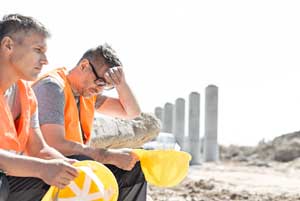If you work on a building site, you know that the summer heat can be a real challenge. With temperatures soaring, it's important to take precautions to avoid heat-related illnesses and injuries. In this article, we'll explore some tips and strategies for staying safe and healthy in the heat.
First and foremost, it's essential to stay hydrated. When you're working in the sun, you're losing fluids through sweat, and it's important to replenish those fluids regularly. Make sure you have access to plenty of water on site, and take regular breaks to drink. You might also consider drinking sports drinks that contain electrolytes to help replace the minerals you lose through sweating.
Understanding Heat Hazards on Building Sites
Working on a building site in the summer can be challenging. The heat can be unbearable, and if you're not careful, it can lead to heat exhaustion or heat stroke. It's essential to understand the heat hazards on a building site to protect yourself.
Heat Stress
Heat stress occurs when your body can't cool down enough to maintain a healthy temperature. It can lead to heat exhaustion or heat stroke. Some of the symptoms of heat stress include:
- Excessive sweating
- Fatigue
- Dizziness
- Headaches
- Nausea
- Muscle cramps
If you experience any of these symptoms, it's crucial to take a break and cool down.
Dehydration
Dehydration can occur when you're not drinking enough water to replace the fluids lost through sweating. It can lead to headaches, dizziness, and fatigue. To avoid dehydration, it's essential to drink plenty of water throughout the day. You should aim to drink at least 2 litres of water per day.
Sunburn
Working on a building site means spending a lot of time outside in the sun. Sunburn can be painful and increase your risk of skin cancer. To protect yourself from sunburn, you should:
- Wear protective clothing, such as long-sleeved shirts and hats
- Apply sunscreen with an SPF of at least 30
- Take regular breaks in the shade
Hot Surfaces
Building sites can have hot surfaces, such as metal or concrete. These surfaces can cause burns if you touch them. To avoid burns, you should:
- Wear protective gloves
- Use tools to handle hot objects
- Avoid touching hot surfaces with your bare skin
Conclusion
Understanding the heat hazards on a building site is essential to protect yourself from heat stress, dehydration, sunburn, and burns. By taking the necessary precautions, you can stay safe and healthy while working on a building site.
Implementing Heat Safety Measures
When working on a building site during hot weather, it is essential to implement safety measures to prevent heat-related illnesses. Here are some measures you can take:
Proper Hydration
It is crucial to drink plenty of water throughout the day, even if you don't feel thirsty. Dehydration can occur quickly in hot weather, and it can lead to heat exhaustion and heatstroke. You should aim to drink at least 250ml of water every 15-20 minutes. Avoid drinks with caffeine or alcohol, as they can increase dehydration.
Shade and Rest Breaks
Working in direct sunlight can increase your risk of heat-related illnesses. Whenever possible, work in shaded areas or use umbrellas to protect yourself from the sun. Take regular rest breaks in a cool, shaded area to allow your body to cool down. Rest breaks should be taken every 30 minutes to an hour.
Heat Illness Training
All workers on the building site should receive heat illness training. This training should include information on the signs and symptoms of heat exhaustion and heatstroke, as well as how to prevent them. Workers should be trained to recognise the signs of heat exhaustion, which include headache, dizziness, nausea, and weakness. If any of these symptoms are present, the worker should stop working immediately and seek medical attention.
Implementing these heat safety measures can help prevent heat-related illnesses on a building site. Remember to stay hydrated, take regular rest breaks in shaded areas, and receive heat illness training.


